The Crusades
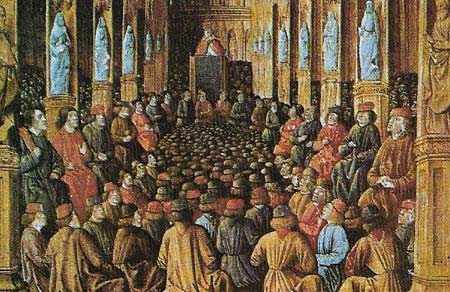
Figure 1. Pope Urban II's appeal to the Council of Clermont (1095) launched the First Crusade and was an attempt to reconcile Church and state. The reply to his call, a shout of "Deus vult" (God wills it), later became the battle-cry of Crusader-knights in the Holy Land. His appeal led to the spontaneous and ill-disciplined People's Crusade (1096). The Pope's appeal to biblical images of Jerusalem, the heavenly city, made the idea of freeing the earthly city one of great splendor and power. The Pope reinforced his appeal with calculated references to Western overcrowding and famine.
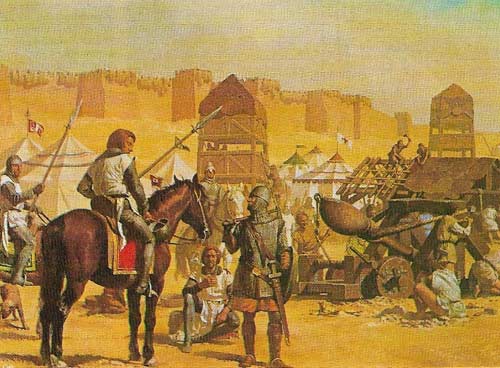
Figure 2. Crusaders besieging Jerusalem in June and July 1099, faced fortifications more complex than any in northern Europe. A quick assault was necessary as the defenders had poisoned the wells for 10 kilometers (6 miles) around the city. Wood had to be fetched by sea for the scaling ladders, mangonels (beams that hurled boulders), giant catapults, and trebuchets (slings worked by counterweights). Three wooden "castles" on wheels, to make possible attacks on the upper levels of the walls, were hung with hides to ward off arrows and "Greek fire" (a blazing naptha-based mixture extinguishable only by vinegar). The knights cared for their horses before they looked after themselves; heavy warhorses, trained to charge home against infantry and able to carry a man wearing a third of his own weight again in armor, were irreplaceable in the East. Loss of his horse reduced the knight to the ranks of the foot soldiers. The heat claimed many lives.
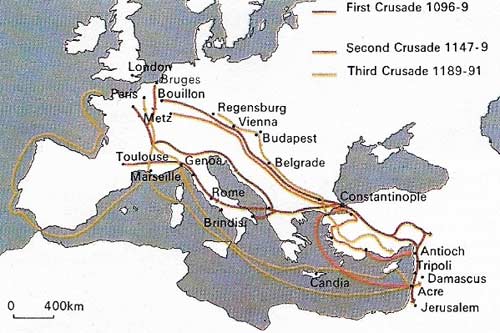
Figure 3. The recovery of the holy places and the protection of the subsequently established Frankish states were the aims of the early Crusaders. The separate armies of the First Crusade (1096–1099), from France, Provence, Normandy, Flanders, and Apulia, joined at meeting-points throughout Europe, marched through Magyar territory to Constantinople and fought their way across Asia Minor. Those of the Second Crusade (1147–1149), led by the kings of France and Germany, also went overland, but their refusal to adapt to conditions of Eastern warfare led to their destruction by the Seljuks of Asia Minor. By the Third Crusade, Western naval strength had improved and Richard I chose a sea route to Acre.
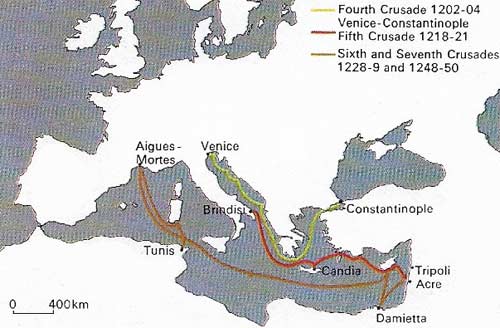
Figure 4. Directly concerned with saving Jerusalem, the 4th–7th Crusades, aroused far less enthusiasm in the West than had their predecessors. Greed and hatred for fellow-Christians in the East made the army of the Fourth Crusade easy prey for the manipulations of Venice. Personal magnetism and negotiating skill brought about what successes by Emperor Frederick II and King Louis IX of France.
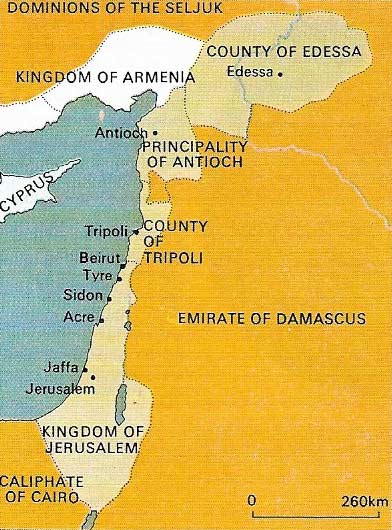
Figure 5. The four Crusader states comprised the County of Edessa (founded 1098), the Principality of Antioch (1098), the Kingdom of Jerusalem (1099), which claimed the overlordship, and the County of Tripoli (1109). The last, the smallest and weakest, had an unexpected ally in the Assassins, an heretical Muslim sect which supported the Franks against Damascus for 200 years. The states were feudal, had their own coinage and traded widely with Europe and the Levant.
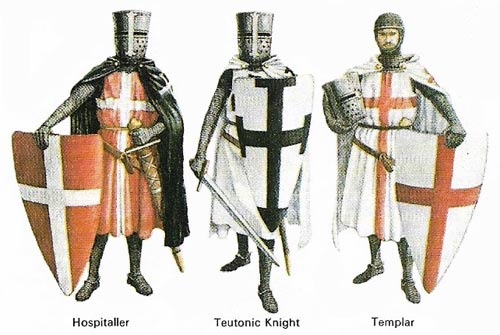
Figure 6. The military orders' offer of a life of religion and battle brought recruits from England, France, Portugal, Spain, and Italy. The Hospitallers began in the 11th century as guardians of the pilgrim hospice of St John in Jerusalem. The first Templars, given their rule by Bernard of Clairvaux in 1128, lived in the palace of the King of Jerusalem, the "Temple". in contrast the Order of Teutonic Knights, founded in 1198, was confined to German nationals only. The orders were answerable only to the pope and held the only standing armies in the East.
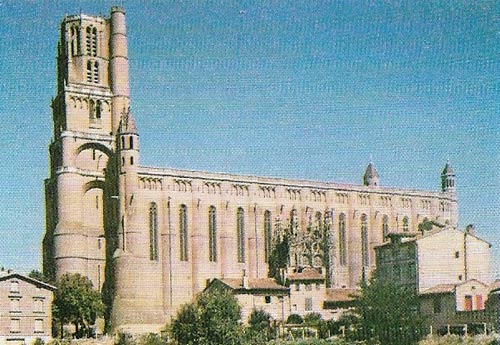
Figure 7. The fortified cathedral of Albi in southern France, founded in 1277, was a deliberate symbol of the Church Militant's triumph over the Cathar heresy, which denied the reality of Christ's incarnation. The Cathars were brutally suppressed by Simon de Montford l'Amaury (1160–1218) in a crusade of 1209, inspired by Innocent III, who introduced the idea of mounting crusades to crush Christian heretics and enemies of the Papacy.
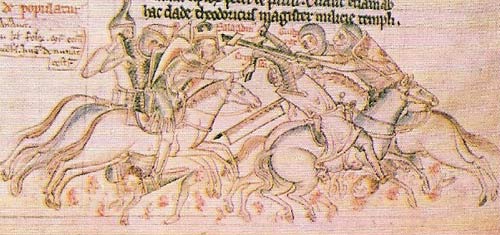
Figure 8. Saladin, a chivalrous and courteous enemy, was taken as an ideal by many Frankish knights. This 13th century drawing from the Chronica Majora of Matthew Paris shows him wrestling a relic of the True Cross from Guy de Lusignan, King of Jerusalem, at the battle of Hattin (1187).
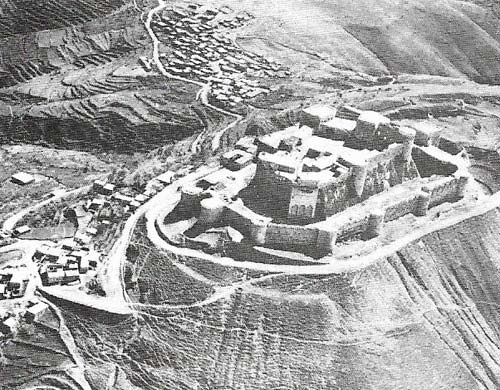
Figure 9. Krak des Chevaliers, best-preserved of Crusader castles, guarded the northwest flank of the County of Tripoli. Begun in 1142 by the early Crusaders, it defied 12 sieges, falling to Baibars in 1271 when itsgarrison of 2,000 was reduced to under 200. Frankish forts were first built by the Templars to protect the pilgrim route to Jersulem and later grew into chains of casles guarding the frontier and ports.
The immediate cause of the First Crusade – and the starting-point for a major stage of European expansion – was the threat to the Byzantine Empire created by the Seljuks. These Muslim tribesmen had conquered the empire's richest province, Anatolia, and farther east had dispossessed the caliphs of Antioch, Tripoli, and Jerusalem. An attack on Constantinople seemed inevitable.
In 1095 the emperor, Alexius I Cornnenus (reigned 1081–1118), an able soldier and diplomat, therefore asked Pope Urban II (1042–1099) for assistance, baiting his request for a contingent of mercenaries to retake Anatolia with the suggestion that they could then travel on to liberate Jerusalem. Urban responded (Figure 1) and for the first time the Papacy sanctioned a "holy war". It promised that whoever undertook this pilgrimage would be freed from all penances due.
The First and Second Crusades
The four separate armies of the First Crusade (3) converged on Constantinople in the winter of 1096–1097: men from Lorraine, the Norman kingdom of Apulia, Provence, Brittany, Normandy, and Flanders. The Franks took Nicaea and Dorylaeum; Antioch fell after a lengthy siege, and the Crusaders stormed Jerusalem in July 1099 (Figure 2).
With the holy places conquered, territorial motive now became paramount. Four Frankish states (Figure 5), defended by the castles and garrisons of the Templars and Hospitallers (Figure 6), survived increasing Muslim pressure until 1144, when Edessa fell. A crusade was called for by Pope Eugenius III (died 1153). Emperor Conrad III (1093–1152) and King Louis VII of France (1121–1180) incompetently led the armies of the Second Crusade (1147–1149) to starvation and disaster in Anatolia.
Jerusalem falls to the Turks
A further revival of Islam and the empire's final loss of Anatolia to the Seljuks in 1176 left the Latin states in danger. Saladin (Salah ad-Din, 1137–1193), the brilliant Kurdish vizier of Egypt, united Islam from the Nile to the Tigris and in 1187 invaded the Latin Kingdom of Jerusalem, and overran the Frankish states.
The armies of the Third Crusade (1189–1191) came to their aid and Frederick I (Barbarossa) (1123–1190), the Holy Roman Emperor, took the Seljuk capital of Iconium. Phillip II Augustus of France (1165–1223) and Richard I of England (1157–1199) joined the ex-King of Jerusalem, Guy of Lusignan (1140–1194), in besieging Acre, which surrendered after a two-year siege. Richard then set out for Jaffa, the port of Jerusalem, and although he won the coast from Tyre to Jaffa for the Christians, was prevented from attacking Jerusalem.
The Fourth Crusade (1202–1204), supported by Pope Innocent III (c. 1160–1216) to restore the kingdom of Jerusalem, resulted in the debasement of the ideal: war was now made against fellow-Christians for gain. Venice, which largely controlled the eastern Mediterranean, forced the army to accept a price for transport to Egypt which it could not pay. The Doge of Venice agreed to remit the debt only if the troops were diverted to repossess Zara on the Adriatic, a former Venetian city taken by the Magyars in 1186. The army was then persuaded to intervene in a Byzantine dynastic quarrel and besiege Constantinople itself. The presence of a Frankish army brought to a head hatred between Greek and Latin Christians, long fostered by mutual blame for successive crusading disasters. In April 1204 the Crusaders seized and looted the city.
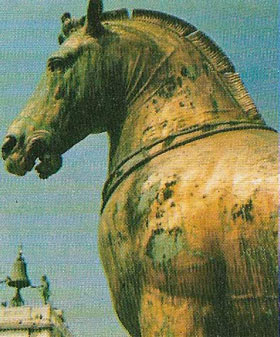 |
| The 6th-century Quadriga of Lysippus, four splendid bronze horses taken during the sack of Constantinople (1204), still stand over the portal of St Mark's, Venice. A less tangible result of the Fourth Crusade was the flow into Western Europe of Greek scholars seeking refuge from the Turks, which gave impetus to the Renaissance. Earlier Crusades imported to the West new goods: damask, muslin carpets, rice, sugar, lemons, spices, dyes; and the Arabic numerals which revolutionized mathematics. |
The Crusaders finally defeated
After the failure of the Fifth Crusade, 1218–1221, the last in which the Papacy was actively involved, the Pope's Hohenstaufen enemy in southern Italy, the Holy Roman Emperor Frederick II (1194–1250), conquered Jerusalem by political means. He claimed its throne through his wife and sailed on the Sixth Crusade (1228–1229) while actually excommunicate. Supported by the Teutonic Knights, he negotiated a ten-year truce that restored Jerusalem (except for the Temple and Muslim holy places) to the Franks. In 1229 Frederick crowned himself King of Jerusalem but, after the truce, quarrels over territory between Templars and Hospitallers so weakened the kingdom that it fell in 1244 to the onslaught of mercenary Turks.
Louis IX of France (St Louis, 1215–1270) made another attack on Cairo in the Seventh Crusade of 1248–1250, but was taken prisoner. Freed by ransom, he rebuilt Jaffa and Acre and conciliated Muslim leaders. His return to France, however, left the kingdom of Jerusalem crumbling because of the renewed rivalry of the military orders. Baibars, Mameluke Sultan of Egypt from 1260 to 1277, took advantage of this division; in 1268 he seized Jaffa and Antioch, and in 1271 the castle of Krak des Chevaliers (Fig 9). Louis IX, mortally ill, set out again on the Eighth Crusade (1270) but died in Tunis; Prince Edward (later Edward I of England, 1239–1307) reached Acre in 1271 and negotiated an 11-year truce, but in 1289 Tripoli fell to the Mamelukes and in 1291 they captured the last stronghold, Acre.
The territorial and spiritual triumphs of the Crusades were short-lived. Urban's vision of a united Christendom degenerated into papal autocracy; the division between Latin and Orthodox Christians became absolute. The West's chief defence against Islam, the Byzantine Empire, was fatally weakened.
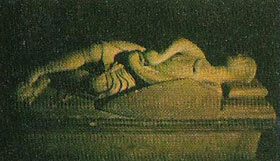 |
| Crusaders' tombs in English churches usually show a knight lying peacefully, his legs crossed. But in Dorchester Abbey, Sir John Holcombe, who died on the Third Crusade, is shown in effigy struggling to draw his sword. |
